Content Frontier – Instant, Personal, Alone, Together

Soon after the release of the Blade Runner remake, SMPTE (Society of Motiion Picture and Entertainment Engineers) held their annual conference to solve today’s problems but also forecast what the industry will be doing in the years ahead to produce, share, distribute and get paid for the content folks will enjoy.
They were all right!
It’s time for a change.
Trouble is all of the SMPTE speakers had great visions of what that change is going to be:
- Living in a virtual/real world
- Pay as you view entertainment
- Everything Free (ad supported)
- Dizzying range of screen options
- Everyone produces/stars, no one produces/stars
- All of the above or none of the above
But whatever tomorrow holds it’s going to be big, huge even!
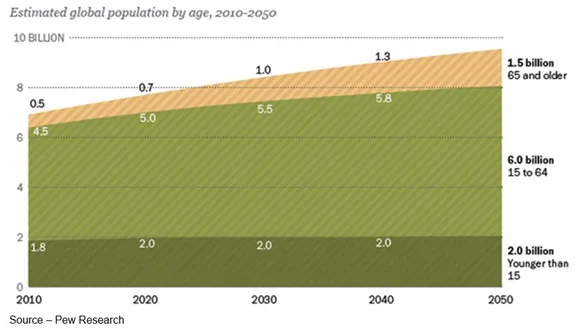
In a mere 30 years:
- The global population will be approaching 10B people with as many as 50M having migrated to Mars, thanks to private and public colonization efforts
- 5G networking will be standard everywhere, enhanced to Terahertz performance
- Today’s Gen Zers will be part of the 1.5B plus boomers/boomers plus and about 2B Gen Charlies (starting over in the alphabet) will have taken their place
- Everything will be connected and personal data will still be somewhat personal being widely shared/used by content providers to deliver the information/content you want, where you want it, when you want it
- We will produce, process, disseminate and consume as much as 4,0008 kilobytes, four yottabytes of data
- General purpose and specialized/personalized AI-based data analysis/decision systems will be in widespread use to help individuals do what they do in their professional and personal lives.
- Commerce and “downtime” will consist of moving information packets from one
place to another and reshaping them bits to/from them
A Bright Starting Point
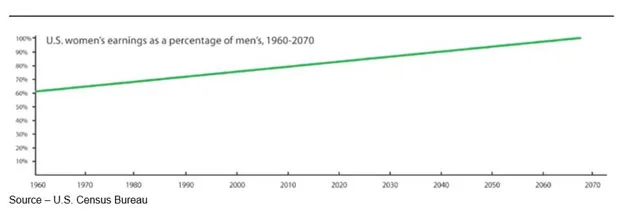
While half of the global population might be discouraged, progress is being made; and by 2050, male and female salaries will be reaching parity
In the developed world, the gender gap will have narrowed to such an extent that salaries and rights will be pretty much equal for both sexes. Women will be playing a greater role in business, government and the content development/distribution industry than ever before.
Shooting
Facebook Live, YouTube, SnapChat and a wide range of online services combined with 8K camera-connected devices will give everyone a platform to express themselves and share their content with others (which can be modified).
It will primarily be the new Gen Cers, who have grown up in an ultra-visual world; who will be uploading as much as 1,000 hours of content every second (mainly 3-15 minutes in length) that will be viewed by billions every day over what is today called “social” media.
While some view each new generation’s preference for rapid-fire, short attention span viewing as a dim forecast for the future of large-small budget filmmakers, it probably won’t happen that way.

Since the beginning of recorded time, visual storytellers and creatives have found a ready and eager audience in the vast population.
This won’t change with the flow of online streaming tidbits. In fact, it will heighten the demand for better quality and a broader range of content. What will be different is where; and even more so than today, how it is viewed.
The storytellers will be using very low-cost 16K UHDR/VR cameras to create immersive stories that people can simply sit and enjoy. True to Andrew Shulkind’s keynote viewers will take control of the storyline and flow, bringing in and dispensing with real or animated characters.
Tomorrow’s visual entertainment will be a true creative collaboration.
On the upside for professional filmmakers, AI-based solutions will be closely tied to content metadata throughout the production process. Piracy will be something your grandparents were concerned about because content will be tied back to the specific storyteller.
We will compensate individual “creators/modifiers” electronically and automatically for their efforts.
When individuals want to slip into strictly the immersed AR/VR mode, they will still don special personal gear even as some view them as a stumbling block to wide-spread acceptance.
The efficiencies of new and advanced software-based codecs will facilitate viewing on 8/16K televisions with new living room-centric viewing controls.
Research and engineering experts believe that for the foreseeable future (25 years), the devices or a neural transplant will be necessary for the AR/VR experience.
The latter isn’t on my shortlist.
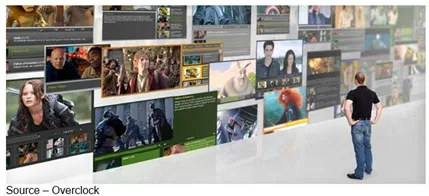
You won’t have to choose whether you’re watching on one of your communications devices; in your mode of transportation or your16K/HDR wall in your living room, family room, media room or bedroom.
Screens will be everywhere – office/home surfaces, modes of transportation, everywhere. An excellent example is Corning’s YouTube video – A Day Made of Glass.
It probably won’t be glass and they’ll be watching you as much as you are watching them.
There won’t be any need to choose a channel from 10, 1,000 or even 10,000.
In fact, even before 2050 there will be over 10B channels – one for every specific person/organization on the planet. And thanks to AI-based solutions and media analytics platforms, you’ll have access to any content anywhere. Channels will be built around the things people do, where they go, their likes/dislikes, moods, relationships, interests … a rich, rewarding channel of one.
Want some content for a few minutes or an hour? Just say the word and the content system will deliver your channel instantly.
Content management firms which could include studios, OTT delivery services (AT&T, Verizon, Rogers, Turner, Viacom, AMC, NBC, Univision, MediaCorp, CCTV, Colors Odia, China Telecom, Tata and other local, national, international carriers) will store, stage and distribute content no matter where you are.
Using present titles as reference, content can be SVOD (subscription video on demand), TVOD (transactional video on demand) or AVOD (advertising video on demand).
Yes, we will still have ads in 2050!
The difference will be that the AI-based solution will deliver precisely the ads you want to consume/consider/enjoy.
If you’re happy and want to celebrate you’ll get really cool, fun type stuff.
If you’re a little down, bummed, depressed; the solution will give you uplifting, morale building, confidence-enabling material and ads.
If you’re aggressive and want to crush/destroy something; you’ll receive conflict/war, adventure, zombie challenges.
If you’re nostalgic, you’ll receive content from 2017 or 2027 and wonder how the old folks tolerated their world back then.
Whatever you’re feeling at the moment will be satisfied by the content you probably didn’t even realize you wanted.
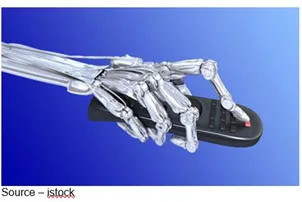
The entertainment/content system will “flip through” millions of video files to offer you material to consider or to meet your specific needs at the time. What’s offered up may not be right 100 percent of the time but all you have to do is say, “Nope, let’s try something else,” and BAM! it will be on your screen.
It won’t just be everywhere, anywhere TV, it will be individually personalized content.
Store Houses
At SMPTE some ultra-practical folks said, “B.S. If we have all of that data streaming in at 16K, 120fps for a one-hour film, you’re talking about10PB of storage per film. Multiply that by even, 1,000 hours of content per day and we don’t have enough cloud data centers to store it.”
True.
Jen Soule of OWC and others in the storage industry were rubbing their hands together with the plans for resolution and contents growth.
It means a robust demand for storage as filmmakers, content managers and file distributors produce, gather and archive content from the four corners of the globe.
“VR, AR, holograms and 16K, HDR content production will produce a whole new set of digital assets that will be managed at the frame level and AI will be able to predict users’ wants and needs based on past behavior for a more fluid, intuitive experience,” states Allan McLennan of PADEM Media. “These available assets in storage will be mapped to the viewer’s behavior – personalized, private and detailed – and will accurately be presented seamlessly and close to instantaneously through AI”
The software, hosting and storage will move from single servers and monoliths toward distributed systems with fog-hosting (decentralized networking) that provide greater efficiency, reduced pressure on the networks and an improved user experience.
The challenge to date according to Microsoft’s lead researcher Karin Strauss is that electronic storage has not kept pace with storage demand. She noted, “If you look at current projections, we can’t store all the information we want with devices at the cost that they are.”
Fortunately, the storage industry is keeping pace with the content industry.
The New Medium
To meet the seemingly unquenchable storage demand, Microsoft successfully demonstrated DNA archive storage in mid-2016.
By 2066, many analysts see spinning disks and tape relegated to virtual museums because of limited storage capacity (compared to size) and short data life (typical HD data life 7 years, LTO tape 30 years).
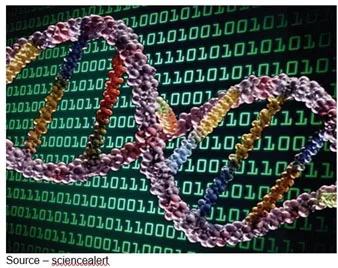
The future content industry requires both capacity and long storage life as well as speed. As a result, flash/solid state memory will have a reprieve and will be used as local content buffer as the AI system determines the content desired and “preloads” content locally.
IDC predicted that the worldwide total of stored digital data would be 16 zettabytes (16 trillion gigabytes) in 2017. Cisco estimates that by 2020, we will be producing 44ZB of data annually.
It’s Big – While having a terabyte of storage on your notebook or half a terabyte on your smartphone will be the answer to your needs, 8K, 16K, HDR and VR content will require expanded storage capacity; which is why by 2017, more than 16 zettabytes of content storage will be required.
A shoebox of DNA would hold roughly 100 ultra-large data centers.
While remarkably dense, human DNA is unstable but super-efficient in storing information that can be easily manipulated.

Strauss and other data scientists are confident that they can make it commercially viable (cheaper) over the next 5–10 years.
Storing data in DNA requires translating the 1s and 0s of binary digital files into long strings of the four different nucleotides – or bases – that make up DNA strands and write out the genetic code (already proven feasible).
Storing digital data on DNA overcomes current data storage because it:
- doesn’t degrade when exposed to magnetic fields or extreme temperatures
- isn’t susceptible to data loss in the event of a power loss
- is long-lasting for thousands of years without degradation
Of course, it will also require a new breed of storage devices to write and read the content; but engineers and their AI assistants will be able to deliver them because … they can.
Over the next 10 years content will expand–and contract. It will become something that is universal and individual.
In our constantly connected, always-on world, communal venues such as theaters will disappear. Like-thinking people, regardless of where they are physically located, will connect and share ideas, activities and events. Interactively, they will create, modify and share entertainment content. Personalized content will be available to them wherever they go.
We will also find that we’re more alone together.
The creative minds of today are already giving us hints as to what tomorrow will look like. “Entertainment” as we think of it today will be an instant, momentary escape from the here and now to the then and there.
SMPTE still has a lot of work to do.
Just remember what Wallace will say in 2049, “Every leap of civilization was built on the back of a disposable workforce, but I can only make so many.”
# # #